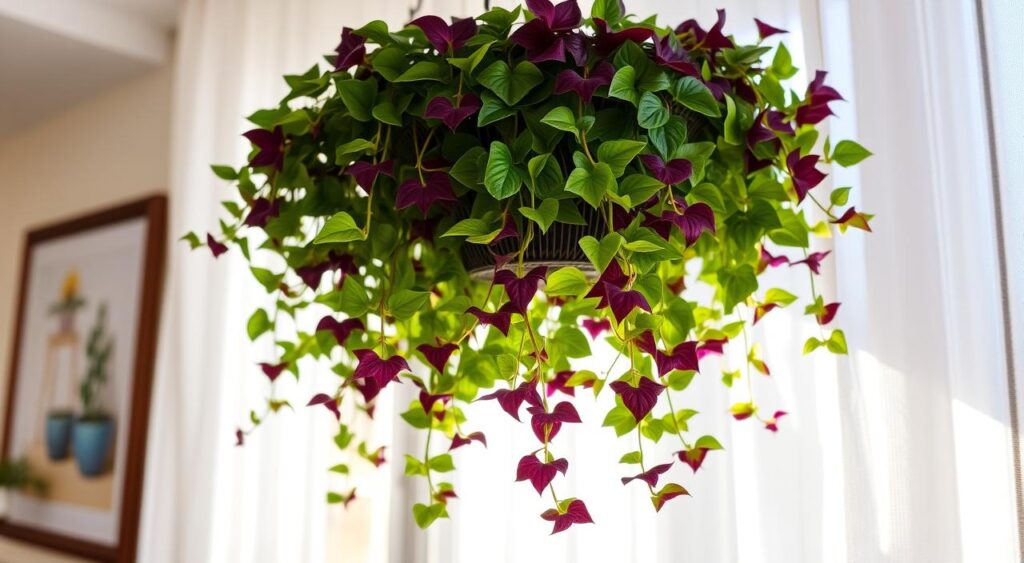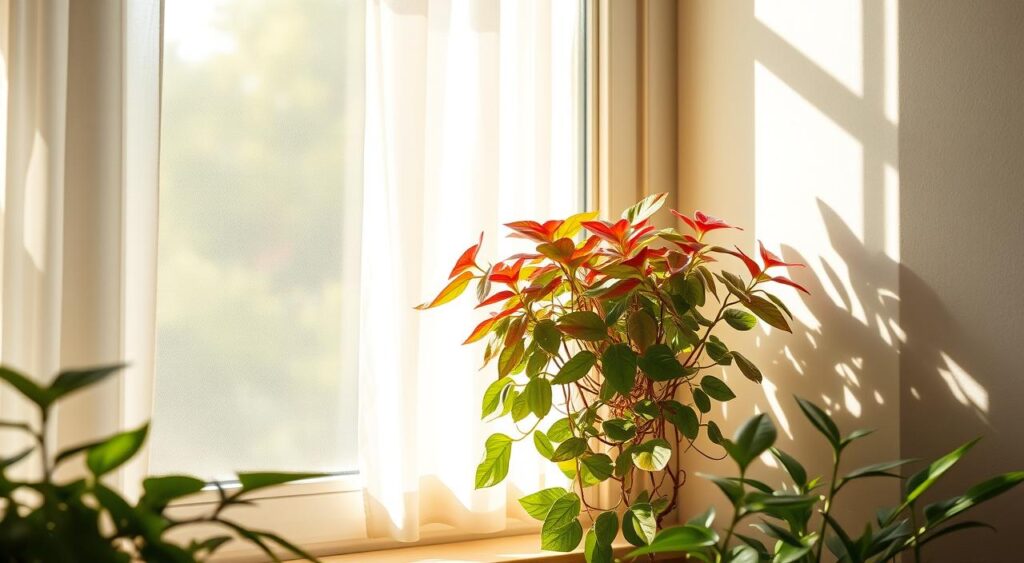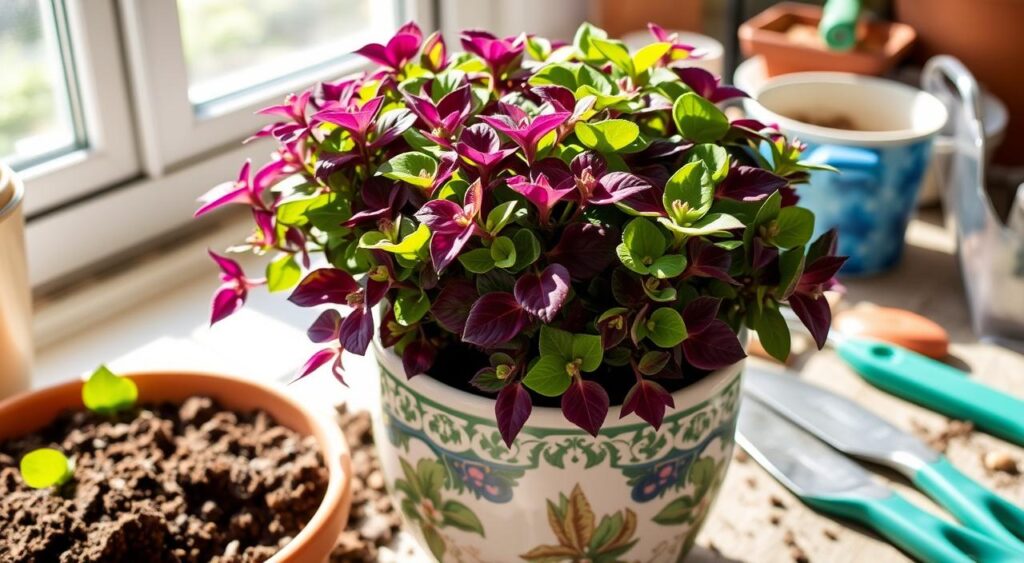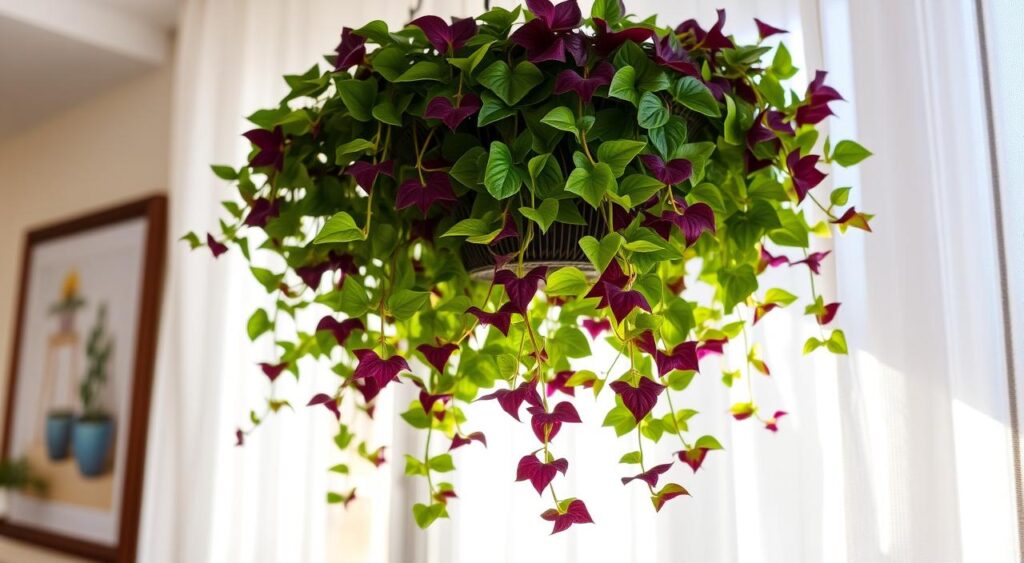Welcome to our guide on growing and caring for the captivating wandering jew plant at home. This article is for both seasoned plant lovers and new gardeners. You’ll learn how to grow this popular trailing houseplant with ease.
As you explore the world of the wandering jew, you’ll learn about its origins and varieties. You’ll also find out how to keep it healthy and vibrant. Get ready to care for your own wandering jew plant and make your home a lush oasis.

Key Takeaways
- Discover the origins and unique characteristics of the wandering jew plant
- Explore the different varieties of wandering jew and their distinct features
- Learn the ideal growing conditions for your wandering jew plant, including light, soil, and watering requirements
- Understand how to properly position and care for your wandering jew plant to ensure its long-term health and vibrancy
- Gain practical tips for managing common watering and humidity challenges when growing the wandering jew
Also Like : The How Of Digital And Analytics In Insurance Thestudypoints
Introduction to the Wandering Jew Plant
The wandering jew plant, also known as Tradescantia, is a fascinating houseplant. It has been loved by plant lovers for many years. These plants come from different parts of the Americas and can grow in many places, both inside and outside.
Origins and Natural Habitat
The Tradescantia genus comes from the warm and temperate areas of the Americas. It grows in moist, well-drained soils. You can find it in wooded areas, by streams, and in shaded gardens. This helps them adapt to different environments.
Different Varieties Available
- Tradescantia zebrina: Known as the “Inch Plant” or “Wandering Jew,” it has bright, striped leaves in purple, green, and silver.
- Tradescantia fluminensis: Called the “Small-Leaf Spiderwort,” it has thin stems and small, oval leaves.
- Tradescantia pallida: Known as the “Purple Heart,” it has deep purple leaves and grows compactly, making it great for containers.
Basic Plant Characteristics
All Tradescantia plants have long stems and lush leaves in green, purple, and silver. Their leaves are often lance-shaped or oval. They also have small, delicate flowers in white, pink, or purple, depending on the type.
“The wandering jew plant is a true testament to the beauty and diversity found in the natural world. Its vibrant foliage and adaptable nature make it a captivating addition to any indoor or outdoor space.”
Ideal Growing Conditions for Your Wandering Jew Plant
To make sure your wandering jew plant does well, it needs the right growing conditions. Temperature, humidity, and other factors are key for its health.
The optimal temperature for these plants is between 65°F to 75°F (18°C to 24°C). They love a warm, airy spot and can’t handle cold or extreme heat. Keeping this temperature all year will help your plant grow strong.
Wandering jews also need the right humidity levels. They do best in a humid environment, between 40% to 60%. If it’s too dry, their leaves might wilt or turn brown. You can use a pebble tray or a small humidifier to keep the humidity just right.
- Optimal temperature range: 65°F to 75°F (18°C to 24°C)
- Ideal humidity levels: 40% to 60%
- Provide a warm, well-ventilated environment
By creating the perfect conditions, your wandering jew plant will grow lush and vibrant. Keep an eye on the temperature and humidity levels to meet your plant’s growth requirements.

“Wandering jew plants are incredibly versatile and can adapt to a wide range of environments, but they thrive when their specific optimal temperature and humidity levels are met.”
Light Requirements and Placement Tips
Understanding your wandering jew plant’s light needs is key. These plants do well in bright indirect light. They can also handle low light tolerance. The right window placement ensures they get the right light.
Direct vs Indirect Sunlight Needs
Wandering jew plants like indirect sunlight. Direct, intense rays can scorch them. Place your plant near a sunny window but not in direct sunlight.
The best spot is a few feet from a south- or west-facing window. This way, your plant gets bright indirect light all day.
Indoor Positioning Guidelines
- Put the plant in a spot with bright indirect light, like a few feet from a sunny window.
- Stay away from direct sunlight to prevent damage and wilting.
- If the leaves start to fade or droop, try a different window placement.
Seasonal Light Adjustments
The light needs of your wandering jew plant change with the seasons. In summer, with longer days, it might need less direct light to avoid burning. In winter, move it closer to a sunny window placement for enough bright indirect light.

“The key to a thriving wandering jew plant is finding the perfect balance between bright indirect light and low light tolerance. With the right window placement, your plant will flourish.”
Soil Requirements and Potting Practices
For a healthy wandering jew plant, soil and potting are key. These plants love well-draining soil to avoid root rot. The best potting mix has organic stuff like peat moss and inorganic bits like perlite.
The container size matters too. Wandering jews do well in slightly tight spaces. Pick a pot a few inches wider than the roots. Repotting every 12-18 months keeps the plant happy and growing.
- Use a well-draining, lightweight potting mix specifically formulated for houseplants.
- Choose a container that is just a few inches wider than the plant’s current root system.
- Repot your wandering jew plant every 12-18 months to provide room for growth.
Focus on the soil and potting to make your wandering jew plant happy at home.

Watering Schedule and Humidity Management
Keeping the right moisture balance is key for your wandering jew plant’s health. The right watering schedule and humidity levels are crucial. They help keep your plant looking lush and vibrant.
Water Requirements
Your wandering jew plant likes moist soil but not too wet. Water it when the top inch of soil feels dry. Make sure to soak the soil well until it drains out the pot’s bottom. Don’t let the soil dry out completely, as it can stress the plant.
Humidity Control Methods
Wandering jew plants love humid environments. To boost humidity, mist the leaves often or use a pebble tray. Placing your plant with others that like humidity can also help.
Common Watering Mistakes
Watch out for overwatering and underwatering. Too much water can cause root rot, while too little can dry out the leaves. Check the soil moisture and adjust your watering to keep it just right.
FAQ
What are the origins and natural habitat of the wandering jew plant?
The wandering jew plant, also known as Tradescantia, comes from tropical Americas. This includes Mexico, the Caribbean, and parts of South America. It loves moist, humid places and grows wild in forests and by rivers.
What are the different varieties of wandering jew plants available?
There are many types of wandering jew plants. Tradescantia zebrina, T. fluminensis, and T. pallida are popular. They have different colors and growth styles, like trailing or upright.
What are the basic characteristics of wandering jew plants?
Wandering jew plants have lush, trailing leaves and grow fast. Their stems can grow long, and leaves vary in shape, size, and color. They’re great for ground cover, hanging baskets, or climbing up supports.
What are the ideal growing conditions for wandering jew plants?
These plants like warm, humid places with temperatures between 65°F and 85°F. They need well-draining soil and should not be too wet. They can grow in various light levels, but more light makes them look better.
How much light do wandering jew plants need, and where should they be placed indoors?
They like bright, indirect light but can handle lower light too. For best growth, place them near sunny windows or in bright rooms. Don’t put them in direct sunlight, as it can burn their leaves. Rotate them to get even light on all sides.
What type of soil and potting practices are best for wandering jew plants?
They do well in draining, rich potting soil or a mix of peat moss, vermiculite, and perlite. Use a pot with holes to drain water and don’t plant too deep. Repot every 12 to 18 months to give them room to grow.
How often should I water my wandering jew plant, and how can I manage humidity levels?
Keep the soil moist but not too wet. Water when the top inch or two feels dry. Mist the leaves to keep humidity up or use a pebble tray. Don’t let the plant sit in water to avoid root rot.









